WebService的wsdl详解
CSDN 2024-07-12 09:33:03 阅读 81
webservice服务的wsdl内容详解,以及如何根据其内容编写调用代码
wsdl示例
展示一个webservice的wsdl,及调用这个接口的Axis客户端
wsdl
<code>This XML file does not appear to have any style information associated with it. The document tree is shown below.
<wsdl:definitions
xmlns:apachesoap="http://xml.apache.org/xml-soap"code>
xmlns:impl="http://10.10.1.190:6889/ormrpc/services/EASLogin"code>
xmlns:intf="http://10.10.1.190:6889/ormrpc/services/EASLogin"code>
xmlns:soapenc="http://schemas.xmlsoap.org/soap/encoding/"code>
xmlns:tns1="urn:client"code>
xmlns:wsdl="http://schemas.xmlsoap.org/wsdl/"code>
xmlns:wsdlsoap="http://schemas.xmlsoap.org/wsdl/soap/"code>
xmlns:xsd="http://www.w3.org/2001/XMLSchema" targetNamespace="http://10.10.1.190:6889/ormrpc/services/EASLogin">code>
<!-- WSDL created by Apache Axis version: 1.4
Built on Apr 22, 2006 (06:55:48 PDT) -->
<wsdl:types>
<schema
xmlns="http://www.w3.org/2001/XMLSchema" targetNamespace="urn:client">code>
<import namespace="http://schemas.xmlsoap.org/soap/encoding/"/>code>
<complexType name="WSContext">code>
<sequence>
<element name="dbType" type="xsd:int"/>code>
<element name="dcName" nillable="true" type="xsd:string"/>code>
<element name="password" nillable="true" type="xsd:string"/>code>
<element name="sessionId" nillable="true" type="xsd:string"/>code>
<element name="slnName" nillable="true" type="xsd:string"/>code>
<element name="userName" nillable="true" type="xsd:string"/>code>
</sequence>
</complexType>
</schema>
</wsdl:types>
<wsdl:message name="loginByLtpaTokenResponse">code>
<wsdl:part name="loginByLtpaTokenReturn" type="tns1:WSContext"></wsdl:part>code>
</wsdl:message>
<wsdl:message name="loginByLtpaTokenRequest">code>
<wsdl:part name="userName" type="xsd:string"></wsdl:part>code>
<wsdl:part name="ltpaToken" type="xsd:string"></wsdl:part>code>
<wsdl:part name="slnName" type="xsd:string"></wsdl:part>code>
<wsdl:part name="dcName" type="xsd:string"></wsdl:part>code>
<wsdl:part name="language" type="xsd:string"></wsdl:part>code>
<wsdl:part name="dbType" type="xsd:int"></wsdl:part>code>
</wsdl:message>
<wsdl:message name="loginResponse2">code>
<wsdl:part name="loginReturn" type="tns1:WSContext"></wsdl:part>code>
</wsdl:message>
<wsdl:message name="logoutResponse">code>
<wsdl:part name="logoutReturn" type="xsd:boolean"></wsdl:part>code>
</wsdl:message>
<wsdl:message name="logoutRequest">code>
<wsdl:part name="userName" type="xsd:string"></wsdl:part>code>
<wsdl:part name="slnName" type="xsd:string"></wsdl:part>code>
<wsdl:part name="dcName" type="xsd:string"></wsdl:part>code>
<wsdl:part name="language" type="xsd:string"></wsdl:part>code>
</wsdl:message>
<wsdl:message name="loginResponse1">code>
<wsdl:part name="loginReturn" type="tns1:WSContext"></wsdl:part>code>
</wsdl:message>
<wsdl:message name="loginRequest2">code>
<wsdl:part name="userName" type="xsd:string"></wsdl:part>code>
<wsdl:part name="password" type="xsd:string"></wsdl:part>code>
<wsdl:part name="slnName" type="xsd:string"></wsdl:part>code>
<wsdl:part name="dcName" type="xsd:string"></wsdl:part>code>
<wsdl:part name="language" type="xsd:string"></wsdl:part>code>
<wsdl:part name="dbType" type="xsd:int"></wsdl:part>code>
<wsdl:part name="authPattern" type="xsd:string"></wsdl:part>code>
<wsdl:part name="isEncodePwd" type="xsd:int"></wsdl:part>code>
</wsdl:message>
<wsdl:message name="loginRequest1">code>
<wsdl:part name="userName" type="xsd:string"></wsdl:part>code>
<wsdl:part name="password" type="xsd:string"></wsdl:part>code>
<wsdl:part name="slnName" type="xsd:string"></wsdl:part>code>
<wsdl:part name="dcName" type="xsd:string"></wsdl:part>code>
<wsdl:part name="language" type="xsd:string"></wsdl:part>code>
<wsdl:part name="dbType" type="xsd:int"></wsdl:part>code>
<wsdl:part name="authPattern" type="xsd:string"></wsdl:part>code>
</wsdl:message>
<wsdl:message name="loginResponse">code>
<wsdl:part name="loginReturn" type="tns1:WSContext"></wsdl:part>code>
</wsdl:message>
<wsdl:message name="loginRequest">code>
<wsdl:part name="userName" type="xsd:string"></wsdl:part>code>
<wsdl:part name="password" type="xsd:string"></wsdl:part>code>
<wsdl:part name="slnName" type="xsd:string"></wsdl:part>code>
<wsdl:part name="dcName" type="xsd:string"></wsdl:part>code>
<wsdl:part name="language" type="xsd:string"></wsdl:part>code>
<wsdl:part name="dbType" type="xsd:int"></wsdl:part>code>
</wsdl:message>
<wsdl:portType name="EASLoginProxy">code>
<wsdl:operation name="login" parameterOrder="userName password slnName dcName language dbType">code>
<wsdl:input message="impl:loginRequest" name="loginRequest"></wsdl:input>code>
<wsdl:output message="impl:loginResponse" name="loginResponse"></wsdl:output>code>
</wsdl:operation>
<wsdl:operation name="login" parameterOrder="userName password slnName dcName language dbType authPattern">code>
<wsdl:input message="impl:loginRequest1" name="loginRequest1"></wsdl:input>code>
<wsdl:output message="impl:loginResponse1" name="loginResponse1"></wsdl:output>code>
</wsdl:operation>
<wsdl:operation name="login" parameterOrder="userName password slnName dcName language dbType authPattern isEncodePwd">code>
<wsdl:input message="impl:loginRequest2" name="loginRequest2"></wsdl:input>code>
<wsdl:output message="impl:loginResponse2" name="loginResponse2"></wsdl:output>code>
</wsdl:operation>
<wsdl:operation name="logout" parameterOrder="userName slnName dcName language">code>
<wsdl:input message="impl:logoutRequest" name="logoutRequest"></wsdl:input>code>
<wsdl:output message="impl:logoutResponse" name="logoutResponse"></wsdl:output>code>
</wsdl:operation>
<wsdl:operation name="loginByLtpaToken" parameterOrder="userName ltpaToken slnName dcName language dbType">code>
<wsdl:input message="impl:loginByLtpaTokenRequest" name="loginByLtpaTokenRequest"></wsdl:input>code>
<wsdl:output message="impl:loginByLtpaTokenResponse" name="loginByLtpaTokenResponse"></wsdl:output>code>
</wsdl:operation>
</wsdl:portType>
<wsdl:binding name="EASLoginSoapBinding" type="impl:EASLoginProxy">code>
<wsdlsoap:binding style="rpc" transport="http://schemas.xmlsoap.org/soap/http"/>code>
<wsdl:operation name="login">code>
<wsdlsoap:operation soapAction=""/>code>
<wsdl:input name="loginRequest">code>
<wsdlsoap:body encodingStyle="http://schemas.xmlsoap.org/soap/encoding/" namespace="http://login.webservice.bos.kingdee.com" use="encoded"/>code>
</wsdl:input>
<wsdl:output name="loginResponse">code>
<wsdlsoap:body encodingStyle="http://schemas.xmlsoap.org/soap/encoding/" namespace="http://10.10.1.190:6889/ormrpc/services/EASLogin" use="encoded"/>code>
</wsdl:output>
</wsdl:operation>
<wsdl:operation name="login">code>
<wsdlsoap:operation soapAction=""/>code>
<wsdl:input name="loginRequest1">code>
<wsdlsoap:body encodingStyle="http://schemas.xmlsoap.org/soap/encoding/" namespace="http://login.webservice.bos.kingdee.com" use="encoded"/>code>
</wsdl:input>
<wsdl:output name="loginResponse1">code>
<wsdlsoap:body encodingStyle="http://schemas.xmlsoap.org/soap/encoding/" namespace="http://10.10.1.190:6889/ormrpc/services/EASLogin" use="encoded"/>code>
</wsdl:output>
</wsdl:operation>
<wsdl:operation name="login">code>
<wsdlsoap:operation soapAction=""/>code>
<wsdl:input name="loginRequest2">code>
<wsdlsoap:body encodingStyle="http://schemas.xmlsoap.org/soap/encoding/" namespace="http://login.webservice.bos.kingdee.com" use="encoded"/>code>
</wsdl:input>
<wsdl:output name="loginResponse2">code>
<wsdlsoap:body encodingStyle="http://schemas.xmlsoap.org/soap/encoding/" namespace="http://10.10.1.190:6889/ormrpc/services/EASLogin" use="encoded"/>code>
</wsdl:output>
</wsdl:operation>
<wsdl:operation name="logout">code>
<wsdlsoap:operation soapAction=""/>code>
<wsdl:input name="logoutRequest">code>
<wsdlsoap:body encodingStyle="http://schemas.xmlsoap.org/soap/encoding/" namespace="http://login.webservice.bos.kingdee.com" use="encoded"/>code>
</wsdl:input>
<wsdl:output name="logoutResponse">code>
<wsdlsoap:body encodingStyle="http://schemas.xmlsoap.org/soap/encoding/" namespace="http://10.10.1.190:6889/ormrpc/services/EASLogin" use="encoded"/>code>
</wsdl:output>
</wsdl:operation>
<wsdl:operation name="loginByLtpaToken">code>
<wsdlsoap:operation soapAction=""/>code>
<wsdl:input name="loginByLtpaTokenRequest">code>
<wsdlsoap:body encodingStyle="http://schemas.xmlsoap.org/soap/encoding/" namespace="http://login.webservice.bos.kingdee.com" use="encoded"/>code>
</wsdl:input>
<wsdl:output name="loginByLtpaTokenResponse">code>
<wsdlsoap:body encodingStyle="http://schemas.xmlsoap.org/soap/encoding/" namespace="http://10.10.1.190:6889/ormrpc/services/EASLogin" use="encoded"/>code>
</wsdl:output>
</wsdl:operation>
</wsdl:binding>
<wsdl:service name="EASLoginProxyService">code>
<wsdl:port binding="impl:EASLoginSoapBinding" name="EASLogin">code>
<wsdlsoap:address location="http://10.10.1.190:6889/ormrpc/services/EASLogin"/>code>
</wsdl:port>
</wsdl:service>
</wsdl:definitions>
Axis客户端
用于调用上面的webservice服务
<dependency>
<groupId>org.apache.axis</groupId>
<artifactId>axis</artifactId>
<version>1.4</version>
</dependency>
import client.WSContext;
import org.apache.axis.client.Call;
import org.apache.axis.client.Service;
import org.apache.axis.encoding.XMLType;
import org.w3c.dom.Document;
import javax.xml.namespace.QName;
import javax.xml.rpc.ParameterMode;
import javax.xml.rpc.ServiceException;
import javax.xml.soap.*;
import java.net.MalformedURLException;
import java.net.URL;
import java.rmi.RemoteException;
public static void other(){
QName returnType = new javax.xml.namespace.QName("urn:client", "WSContext");
Object result = null;
try {
// 创建一个新的Service对象
Service service = new Service();
Call call = (Call) service.createCall();
// 设置目标webservice地址,注意去掉 问号与wsdl
call.setTargetEndpointAddress(new URL("http://10.10.1.190:6889/ormrpc/services/EASLogin"));
//设置方法名
call.setOperationName(new QName( "login"));
// 设置传入参数的xml及类型,可以不写
//call.addParameter("userName", XMLType.XSD_STRING, ParameterMode.IN);
//call.addParameter("password", XMLType.XSD_STRING, ParameterMode.IN);
//call.addParameter("slnName", XMLType.XSD_STRING, ParameterMode.IN);
//call.addParameter("dcName", XMLType.XSD_STRING, ParameterMode.IN);
//call.addParameter("language", XMLType.XSD_STRING, ParameterMode.IN);
//call.addParameter("dbType", XMLType.XSD_INT, ParameterMode.IN);
// 设置返回参数的xml及类型,设置请求参数时要写参数名,而返回值不用
call.setReturnType(returnType);
call.setReturnClass(WSContext.class);
//设置返回值名字,可以不写
//call.setReturnQName(new QName("", "loginReturn"));
//设置axis的序列化,否则无法接受自定义类型WSContext
Class sf = org.apache.axis.encoding.ser.BeanSerializerFactory.class;
Class df = org.apache.axis.encoding.ser.BeanDeserializerFactory.class;
call.registerTypeMapping(WSContext.class, returnType, sf, df, false);
// 构造请求的参数
String userName = "xdgt";
String password = "123456";
String slnName = "eas";
String dcName = "gg01";
String language = "L2";
Integer dbType = 2;
// 调用WebService方法
WSContext ws = (WSContext) call.invoke(new Object[] { userName, password, slnName, dcName, language, dbType});
// 处理返回的结果
System.out.println("Response: " + ws.getSessionId());
} catch (Exception e) {
result = "{\"status\": \"error\",\"msg\":\"" + e.getMessage() + "\"}";
}
System.out.println(result);
}
返回类型
WSContext代码,这个建议用axis命令生成,因为内部涉及wsdl的拼接,比较麻烦,而且实际开发中,有可能你并不了解对方的代码结构
axis命令生成参考:
https://blog.csdn.net/onePlus5T/article/details/139122866
/**
* WSContext.java
*
* This file was auto-generated from WSDL
* by the Apache Axis 1.4 Apr 22, 2006 (06:55:48 PDT) WSDL2Java emitter.
*/
package client;
public class WSContext implements java.io.Serializable {
private int dbType;
private String dcName;
private String password;
private String sessionId;
private String slnName;
private String userName;
public WSContext() {
}
public WSContext(
int dbType,
String dcName,
String password,
String sessionId,
String slnName,
String userName) {
this.dbType = dbType;
this.dcName = dcName;
this.password = password;
this.sessionId = sessionId;
this.slnName = slnName;
this.userName = userName;
}
/**
* Gets the dbType value for this WSContext.
*
* @return dbType
*/
public int getDbType() {
return dbType;
}
/**
* Sets the dbType value for this WSContext.
*
* @param dbType
*/
public void setDbType(int dbType) {
this.dbType = dbType;
}
/**
* Gets the dcName value for this WSContext.
*
* @return dcName
*/
public String getDcName() {
return dcName;
}
/**
* Sets the dcName value for this WSContext.
*
* @param dcName
*/
public void setDcName(String dcName) {
this.dcName = dcName;
}
/**
* Gets the password value for this WSContext.
*
* @return password
*/
public String getPassword() {
return password;
}
/**
* Sets the password value for this WSContext.
*
* @param password
*/
public void setPassword(String password) {
this.password = password;
}
/**
* Gets the sessionId value for this WSContext.
*
* @return sessionId
*/
public String getSessionId() {
return sessionId;
}
/**
* Sets the sessionId value for this WSContext.
*
* @param sessionId
*/
public void setSessionId(String sessionId) {
this.sessionId = sessionId;
}
/**
* Gets the slnName value for this WSContext.
*
* @return slnName
*/
public String getSlnName() {
return slnName;
}
/**
* Sets the slnName value for this WSContext.
*
* @param slnName
*/
public void setSlnName(String slnName) {
this.slnName = slnName;
}
/**
* Gets the userName value for this WSContext.
*
* @return userName
*/
public String getUserName() {
return userName;
}
/**
* Sets the userName value for this WSContext.
*
* @param userName
*/
public void setUserName(String userName) {
this.userName = userName;
}
private Object __equalsCalc = null;
public synchronized boolean equals(Object obj) {
if (!(obj instanceof WSContext)) return false;
WSContext other = (WSContext) obj;
if (obj == null) return false;
if (this == obj) return true;
if (__equalsCalc != null) {
return (__equalsCalc == obj);
}
__equalsCalc = obj;
boolean _equals;
_equals = true &&
this.dbType == other.getDbType() &&
((this.dcName==null && other.getDcName()==null) ||
(this.dcName!=null &&
this.dcName.equals(other.getDcName()))) &&
((this.password==null && other.getPassword()==null) ||
(this.password!=null &&
this.password.equals(other.getPassword()))) &&
((this.sessionId==null && other.getSessionId()==null) ||
(this.sessionId!=null &&
this.sessionId.equals(other.getSessionId()))) &&
((this.slnName==null && other.getSlnName()==null) ||
(this.slnName!=null &&
this.slnName.equals(other.getSlnName()))) &&
((this.userName==null && other.getUserName()==null) ||
(this.userName!=null &&
this.userName.equals(other.getUserName())));
__equalsCalc = null;
return _equals;
}
private boolean __hashCodeCalc = false;
public synchronized int hashCode() {
if (__hashCodeCalc) {
return 0;
}
__hashCodeCalc = true;
int _hashCode = 1;
_hashCode += getDbType();
if (getDcName() != null) {
_hashCode += getDcName().hashCode();
}
if (getPassword() != null) {
_hashCode += getPassword().hashCode();
}
if (getSessionId() != null) {
_hashCode += getSessionId().hashCode();
}
if (getSlnName() != null) {
_hashCode += getSlnName().hashCode();
}
if (getUserName() != null) {
_hashCode += getUserName().hashCode();
}
__hashCodeCalc = false;
return _hashCode;
}
// Type metadata
private static org.apache.axis.description.TypeDesc typeDesc =
new org.apache.axis.description.TypeDesc(WSContext.class, true);
static {
typeDesc.setXmlType(new javax.xml.namespace.QName("urn:client", "WSContext"));
org.apache.axis.description.ElementDesc elemField = new org.apache.axis.description.ElementDesc();
elemField.setFieldName("dbType");
elemField.setXmlName(new javax.xml.namespace.QName("", "dbType"));
elemField.setXmlType(new javax.xml.namespace.QName("http://www.w3.org/2001/XMLSchema", "int"));
elemField.setNillable(false);
typeDesc.addFieldDesc(elemField);
elemField = new org.apache.axis.description.ElementDesc();
elemField.setFieldName("dcName");
elemField.setXmlName(new javax.xml.namespace.QName("", "dcName"));
elemField.setXmlType(new javax.xml.namespace.QName("http://www.w3.org/2001/XMLSchema", "string"));
elemField.setNillable(true);
typeDesc.addFieldDesc(elemField);
elemField = new org.apache.axis.description.ElementDesc();
elemField.setFieldName("password");
elemField.setXmlName(new javax.xml.namespace.QName("", "password"));
elemField.setXmlType(new javax.xml.namespace.QName("http://www.w3.org/2001/XMLSchema", "string"));
elemField.setNillable(true);
typeDesc.addFieldDesc(elemField);
elemField = new org.apache.axis.description.ElementDesc();
elemField.setFieldName("sessionId");
elemField.setXmlName(new javax.xml.namespace.QName("", "sessionId"));
elemField.setXmlType(new javax.xml.namespace.QName("http://www.w3.org/2001/XMLSchema", "string"));
elemField.setNillable(true);
typeDesc.addFieldDesc(elemField);
elemField = new org.apache.axis.description.ElementDesc();
elemField.setFieldName("slnName");
elemField.setXmlName(new javax.xml.namespace.QName("", "slnName"));
elemField.setXmlType(new javax.xml.namespace.QName("http://www.w3.org/2001/XMLSchema", "string"));
elemField.setNillable(true);
typeDesc.addFieldDesc(elemField);
elemField = new org.apache.axis.description.ElementDesc();
elemField.setFieldName("userName");
elemField.setXmlName(new javax.xml.namespace.QName("", "userName"));
elemField.setXmlType(new javax.xml.namespace.QName("http://www.w3.org/2001/XMLSchema", "string"));
elemField.setNillable(true);
typeDesc.addFieldDesc(elemField);
}
}
wsdl标签大意
♦ types元素
使用XML模式语言,声明在WSDL文档中的其他位置使用的复杂数据类型与元素,可理解为就是**定义webservice方法请求与响应参数的**
♦ import元素
类似于XML模式文档中的import元素,用于从其他WSDL文档中导入WSDL定义;
♦ message元素
使用在WSDL文档的type元素中定义或在import元素引用的外部WSDL文档中定义的XML模式的内置类型、复杂类型或元素描述了消息的有效负载;
♦ portType元素 和 operation元素
描述了Web服务的接口并定义了他的方法。portType元素和operation元素类似于java接口和接口中定义的方法声明。operation元素使用一个或者多个message类型来定义他的输入和输出的有效负载;
♦ Binding元素
将portType元素和operation元素赋给一个特殊的协议和编码样式;
♦ service元素
负责将Internet地址赋给一个具体的绑定;
具体解释
wsdl:definitions标签
xmlns:xxxx
做此wsdl的定义,里面有很多
xmlns:xxxx,其中后半部分的xxxx会在其他标签中被引用
比如,在上面wsdl文件中的 wsdl:message的Response标签 中,返回类型定义为:type=“tns1:WSContext”,则对应Axis客户端代码就要这样写:
//因为tns1在 <wsdl:definitions>标签 中定义值为 urn:client,所以要向下面这样拼
call.setReturnType(new javax.xml.namespace.QName("urn:client", "WSContext"));
//一般如果不是java中自带的类型,比如string、int等,大概率都是自定义类型,
//此处的WSContext肯定是自定义类型,所以必须在这里赋值class类型,因为Axis不知道WSContext是什么类型
call.setReturnClass(WSContext.class);
假如是 type=“xsd:string”,则对应Axis客户端代码就是:
//xsd属于xml自带标签,进入org.apache.axis.Constants.XSD_STRING的源码可以看见其值就是xsd:string
call.setReturnType(org.apache.axis.Constants.XSD_STRING);
targetNamespace
webserivce的名称空间,一般与方法名拼接一起使用,axis代码使用如下:
call.setOperationName(new QName("名称空间", "方法名"));
注意:
targetNamespace不是必须与方法名拼接在一起进行axis客户端调用,要看wsdl:message标签的方法中是否有前缀
比如下面:方法Response 与 Request 中都有前缀ns0,而ns0的值恰好与targetNamespace一致,所以上面的:
new QName("名称空间", "方法名")
就没问题了
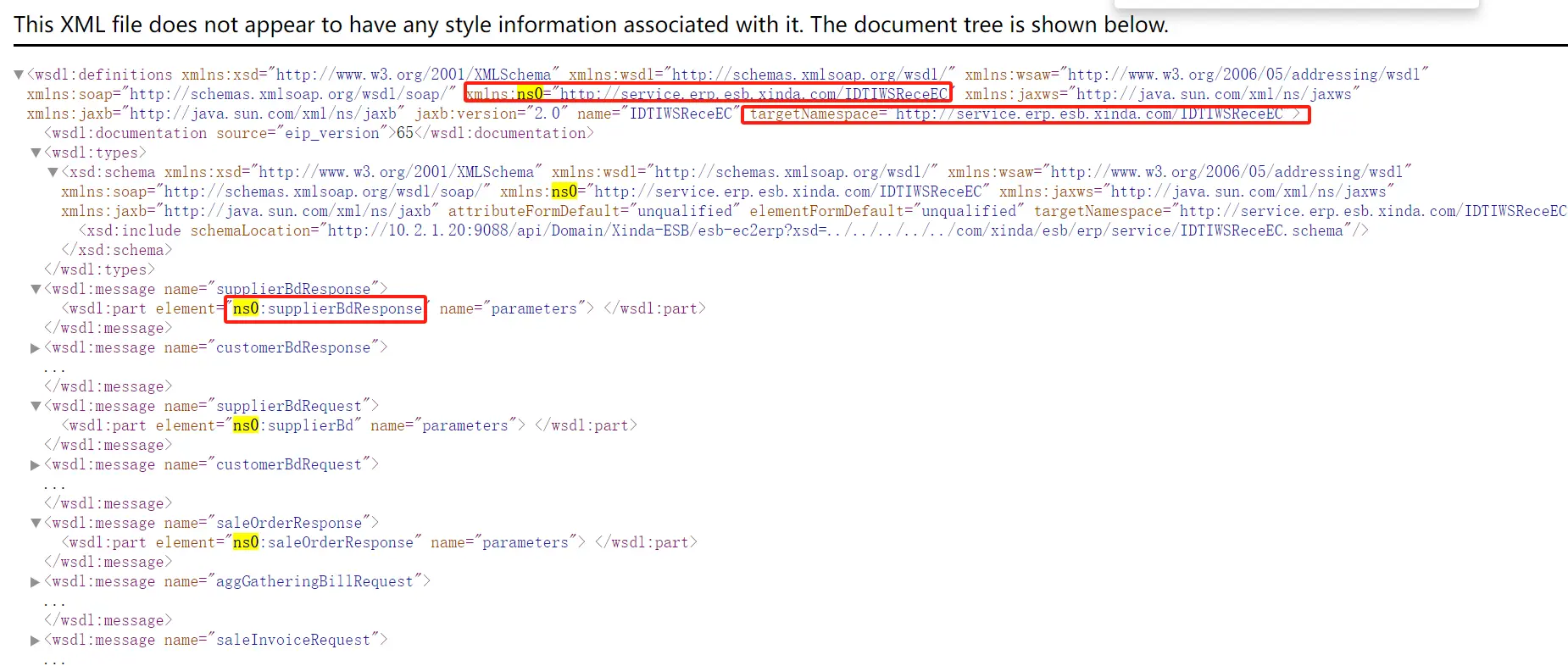
但是本wsdl示例文档的 <code>wsdl:message 标签方法无前缀,比如下图的logout方法:

则axis代码就可以直接写一个方法名:
<code>call.setOperationName(new QName( "logout"));
wsdl:message标签
详解
方法标签,对应发布webservice的接口方法,其中
xxxResponse代表接口方法的返回xxxRequest或者直接xxx方法名代表接口方法的接收
比如本文的wsdl示例文档中的:
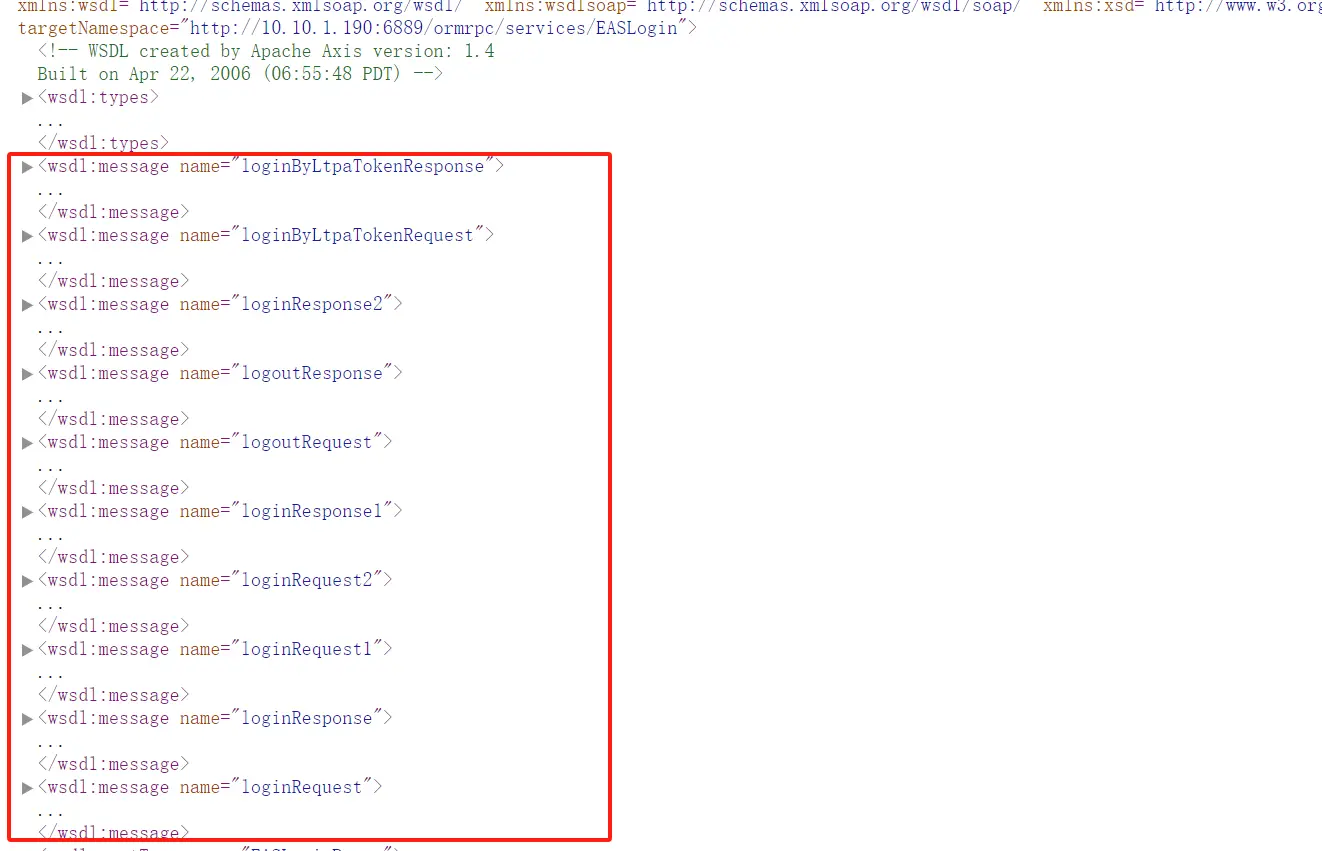
正对应其5个方法:
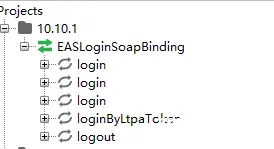
而<code>wsdl:message标签的内容,正对应
请求参数与返回值参数

请求参数对应上图<code>request中的5个返回参数对应上图的tns1:WSContext,也就是下面wsdl:types标签中的类型定义,是5个小类型的合体

axis调用
1.这里对应本文wsdl示例的<code>axis代码调用如下,因为对应方法名的loginRequest、loginResponse没有前缀修饰:
call.setOperationName(new QName( "login"));
2.但如果是下面这种,就必须有前缀对应的QName拼接:

<code>call.setOperationName(new QName("tns在<wsdl:definitions>内定义的值","方法名emeService"));
wsdl:definitions中的tns展示,大部分tns与名称空间targetNamespace相同

wsdl:types标签
详解1
声明在其他标签中要使用的<code>元素和
类型,比如接口方法参数类型、返回值类型
比如本文档示例的wsdl中,wsdl:types标签内容如下,其实就是定义了接口方法的参数类型:
<wsdl:types>
<schema
xmlns="http://www.w3.org/2001/XMLSchema" targetNamespace="urn:client">code>
<import namespace="http://schemas.xmlsoap.org/soap/encoding/"/>code>
<complexType name="WSContext">code>
<sequence>
<element name="dbType" type="xsd:int"/>code>
<element name="dcName" nillable="true" type="xsd:string"/>code>
<element name="password" nillable="true" type="xsd:string"/>code>
<element name="sessionId" nillable="true" type="xsd:string"/>code>
<element name="slnName" nillable="true" type="xsd:string"/>code>
<element name="userName" nillable="true" type="xsd:string"/>code>
</sequence>
</complexType>
</schema>
</wsdl:types>
其中,complexType为一个复合类型,它包含的具体小类型在sequence标签的element中,当我们调用
<wsdl:message name="loginRequest">code>
的方法时,返回的结果格式如下,其实就是返回了WSContext类,这个类包含了其他5个字符串和整数的属性

axis调用1
请求:
<wsdl:message name="loginRequest">code>
<wsdl:part name="userName" type="xsd:string"> </wsdl:part>code>
<wsdl:part name="password" type="xsd:string"> </wsdl:part>code>
<wsdl:part name="slnName" type="xsd:string"> </wsdl:part>code>
<wsdl:part name="dcName" type="xsd:string"> </wsdl:part>code>
<wsdl:part name="language" type="xsd:string"> </wsdl:part>code>
<wsdl:part name="dbType" type="xsd:int"> </wsdl:part>code>
</wsdl:message>
响应:
<wsdl:message name="loginByLtpaTokenResponse">code>
<wsdl:part name="loginByLtpaTokenReturn" type="tns1:WSContext"> </wsdl:part>code>
</wsdl:message>
此
wsdl:types标签对应的调用代码如下
注意:请求参数需要写参数名,设置返回值时不用写返回值名
请求:
call.addParameter("userName", XMLType.XSD_STRING, ParameterMode.IN);
call.addParameter("password", XMLType.XSD_STRING, ParameterMode.IN);
call.addParameter("slnName", XMLType.XSD_STRING, ParameterMode.IN);
call.addParameter("dcName", XMLType.XSD_STRING, ParameterMode.IN);
call.addParameter("language", XMLType.XSD_STRING, ParameterMode.IN);
call.addParameter("dbType", XMLType.XSD_INT, ParameterMode.IN);
响应:
//设置wsdl中返回值类型及其修饰标签
call.setReturnType(new QName("urn:client", "WSContext"));
//因为返回值类型为WSContext,不是基本类型,所以必须设置其calss类,否则报错
call.setReturnClass(WSContext.class);
这个响应的返回值类型,推荐由
Axis的命令直接生成,内部构成比较复杂
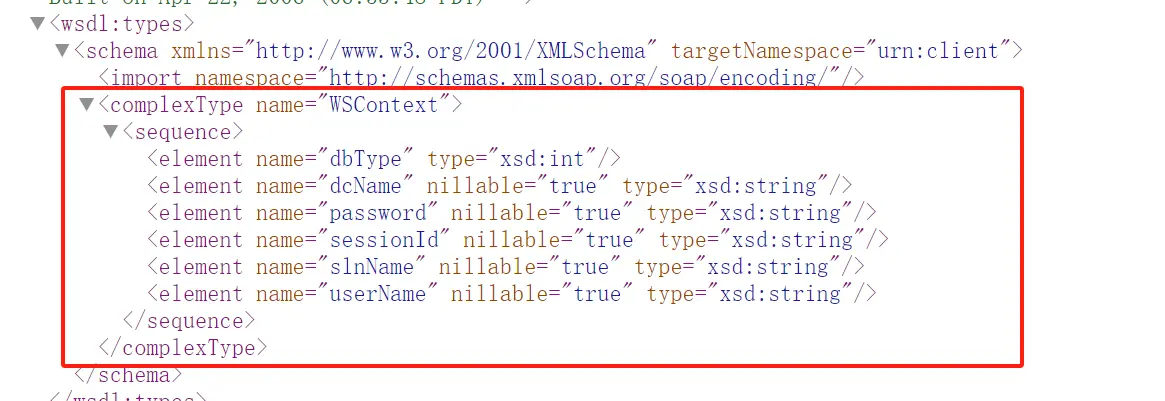
详解2
在举一个不同格式的例子
下面这种格式的<code>wsdl:types标签,与上面大同小异,意思就是:
在wsdl:types中,定义了**emeService方法 ** 的
请求参数类型是String,名称是arg0返回值类型是String,名称是return
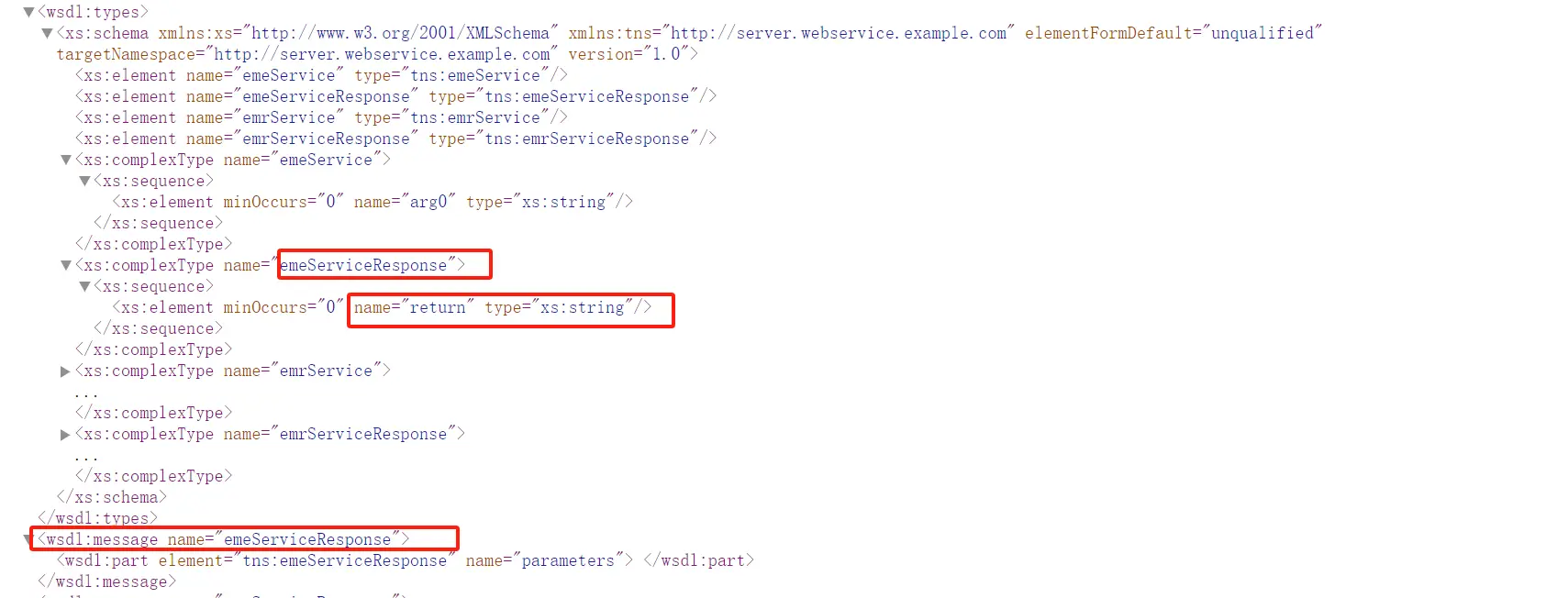
结果证明:

axis调用2
上面的返回值名字为<code>return,类型为
xs:string
注意:axis设置请求参数时需要写参数名,而设置返回值时不用写返回值名
xs:string在axis中可以用代码XMLType.XSD_STRING标识,java基本类型都可以用XMLType表示
call.setReturnType(XMLType.XSD_STRING);
wsdl:portType标签
表达了发布
webservice接口的代码结构
以本文wsdl文档示例为例:
wsdl:portType的name的值:一般对应发布webservice的接口名。wsdl:operation的name的值:对应webservice接口的方法名,parameterOrder为方法参数名。wsdl:input与wsdl:output:对应了输入输出,即接口方法请求与返回的message定义,可以根据其name名字去wsdl:message标签找对应的方法定义。
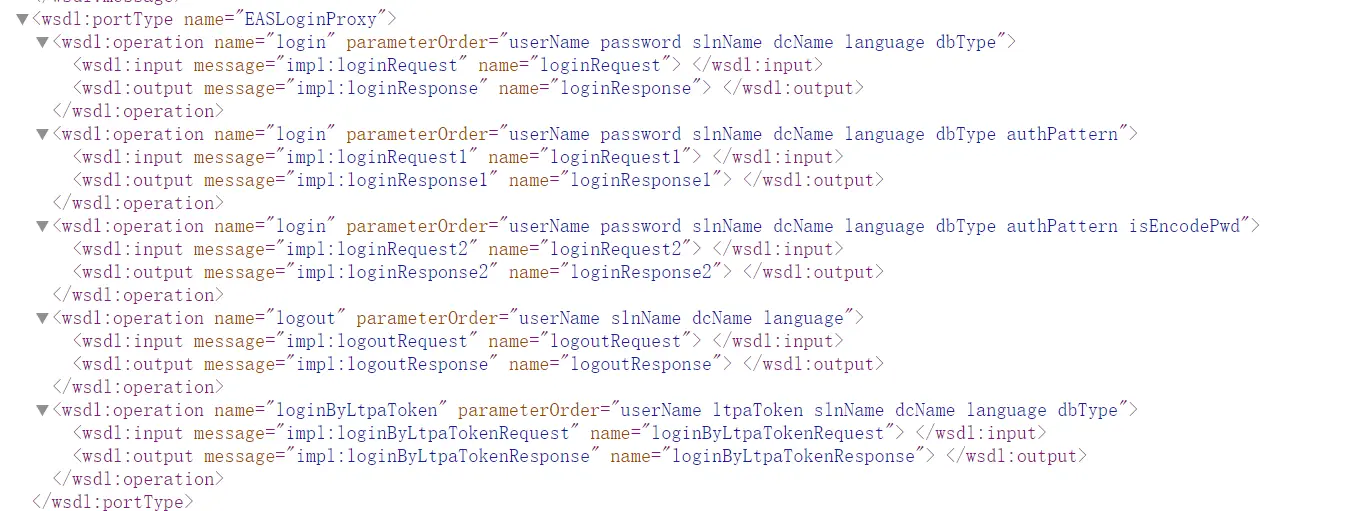
wsdl:binding与wsdl:service标签
好像不涉及Axis代码调用需要编写的部分,暂时没有仔细分析
Binding - 特定端口类型的具体协议和数据格式规范的绑定。Port - 定义为协议/数据格式绑定与具体Web访问地址组合的单个服务访问点。Service- 相关服务访问点的集合。
声明
本文内容仅代表作者观点,或转载于其他网站,本站不以此文作为商业用途
如有涉及侵权,请联系本站进行删除
转载本站原创文章,请注明来源及作者。